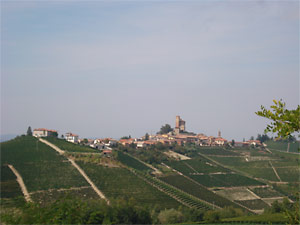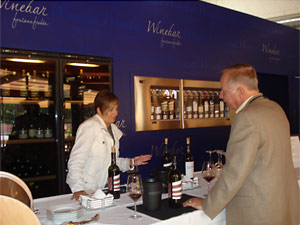Piedmont - A Wine Lover's Paradise
© by Neil Duarte
 |
| The town of Serralunga d’Alba and some of its vineyards. |
Where do you go for that dream vacation if wine is your favorite beverage and you live to eat, not eat to live? One destination you might want to consider is the Langhe Valley in Piedmont in the northwestern part of Italy.
The Langhe Valley is the home of two of Italy's most renowned red wines, Barolo and Barbaresco, produced from the nebbiolo grape. It is a picture perfect collection of rolling hills virtually all of which are planted in some type of vines. The people who live here are very friendly and helpful even if you don't speak Italian (but it helps). Oh, and it doesn't have wall to wall tourists and endless rows of shops selling foreign made souvenirs of the area. What it does have is great wine and superb local food.
Despite the fame of the king, Barolo, and its queen, Barbaresco, the nebbiolo grape is not the most planted grape in the Langhe Valley. That honor goes to Barbera, an excellent grape in its own right. Also planted in abundance is Dolcetto, originally thought to be the Langhe answer to Beaujolais but today being made into some excellent red wines that have far greater aging power than Beaujolais (though most Dolcetto is drunk when young).
It is interesting to note that when eating in the various local restaurants, the house wine (vino rosso di casa) will probably be one of the many versions of Dolcetto produced in the Langhe Valley. It is very reasonable in price and pleasing to drink. One note for those confused when they see bottles of Dolcetto where the word Dolcetto is followed by other names. These names simply indicate which of the seven DOC regulations under which is was produced and generally relate to the nearest town, eg. Alba, Asti, etc.
On a recent visit to the Langhe Valley, my wife and I stayed in the quaint small town of Serralunga d'Alba in a lovely inn, Ca d'Calin. Serralunga is one of the three major production areas for Barolo. These are LaMorra, Serralunga and Barolo. Surprisingly, this is their ranking in the amount of production of Barolo. My quest was to visit a number of local wineries that produce Barolo, large and small, and then sample the typical dishes of the area in the local eating establishments.
Barolo carries Italy's highest application, DOCG (Denominazione di Origine Controllata e Garantita). As such, the wine must meet very exacting production standards including three years aging, two in the barrel. Reserva wines must be aged for five years. Though there are a number of relatively large wineries in the area, a reasonable amount of Barolo is still produced by small wineries, the legacy of the farmer-winemakers of the past. As most wine lovers know, lack of size in a winery is not a detriment to quality production.
 |
| Neil Duarte and Signora Ornella Gallo tasting the wines of Fontanafredda. |
My first winery visit was to the largest producer of Barolo in the Langhe Valley, Fontanafredda. The winery, located just outside of Serralunga, is a work of art. The winery started over 130 years ago as the hunting lodge and home for the mistress of the king of Piedmont. Fortunately, their first son was a passionate winemaker and founded Mirafiorri Vini Italiani, the predecessor to Fontanafredda. The original winery specialized in Barolo and that attention to quality continues today.
Like many other wineries in Piedmont, Fontanafredda owns vineyards located throughout the Langhe Valley. It grows nebbiolo, barbera, dolcetto and moscato grapes in this area. It also owns vineyards in other parts of Piedmont and produces sparkling white Asti and Gavi. In response to the importer/distributor desires, Fontanafredda offers a full line of red and white wines including dessert wines. With all these offerings, you might ask if the wines, particularly the Barolos, are of the highest quality.
After touring the winery and tasting the wines with Signora Ornella Gallo, my opinion is that Fontanafredda has sacrificed nothing in quality in their expanded offering. The Barolos were superb as were the other wines I tasted. Of particular note was La LePre, their Dolcetto Diano d'Alba. This may be the best Dolcetto I have yet tasted. This winery definitely deserves the many honors its wines have won over the past few years.
Having enjoyed the scenery and wines at Fontanafredda (www.Fontanafredda.it), only a gourmet meal would end the day properly. We were not disappointed as we dined at Ristorante Italia, a small (everything in Serralunga was small) restaurant owned by the Anselma family. Signora Anselma, who also runs the coffee shop across the street, is the head chef, and her food was marvelous. Her version of Brasato al Barolo (beef cooked in Barolo) was delicious as was the Coniglio alla Cacciatora (rabbit). Adding to the meal was the house wine, a Barbera d'Alba made by the family. Signora Anselma is a sister of the Massolino family, my next winery visit.
The Massolino family has been making wine in Serralunga since 1896 and judging by the wine I tasted, they really know what they are doing. Sometimes listed under the name Vigna Rionda (the name of the estate) in wine books (www.massolino.it), the Massolino brothers produce the complete range of Langhe Valley reds plus a Chardonnay and sweet Moscato. Our visit to the much smaller winery (200,000 bottles/year vs 6,000,000 at Fontanafredda) was every bit as enjoyable. Senor Lorento explained each wine and offered it for tasting. The Massolino Barolo was superb and validated the high rating given them by Luigi Veronelli in the highly respected book The Italian Wine Guide.
My last winery visited in Serralunga was Schiavenza (www.schiavenza.com), another 200,000 bottle/year operation. I had visited here several years before and was quite impressed. It was a pleasure to see that nothing had changed in the interim. Started in 1956 by the Alessandria brothers, the winery is now run by the daughters, Enrica and Maura. Maura's husband, Luca Pira from another famous Langhe Valley wine family, oversees the wine from vine to bottling. Schiavenza also produces a full range of Langhe Valley red wines, all of which are excellent. The Barolo aside, I was most impressed by their Langhe Nebbiolo which was unfortunately sold out at the winery. These wines are available in the USA but you may have to contact their importer, Weygant-Metzler Ltd., to learn your local distributor.
A proper ending to a totally wonderful stay in Serralunga was a dinner at Schiavenza Trattoria attached to the winery. Traditional Piedmont dishes complemented by the winery's excellent wines (or those of other producers if you wish) make a meal in this trattoria an absolute must. The Brasato al Barolo (my second of the stay) was mouth wateringly delicious and a tribute to the head chef, Enrica and Maura's mother, Signora Lucia. It is amazing that a town the size of Serralunga has two such excellent restaurants.
While not visiting wineries we explored the breathtaking valley and most of its small towns. Lunch or dinner was always excellent and not painfully expensive despite the dollars exchange rate with the euro. The next village, Castiglione Falleto (the Falleti family at one time in the past owned most of the valley), held an excellent inn, Locanda al Teatro which served as a house wine the very drinkable Dolcetto d'Alba produced by a winery located in town, Terre del Barolo. They are an up and coming winery.
If you want a relaxing holiday far from the rush of pushy tourists and overcrowded museums, replete with opportunities to sample superb wines, almost exclusively reds, and within very short distances of truly excellent and reasonably priced (by European standards) restaurants, then the Langhe Valley and particularly the town of Serralunga d'Alba offer much for you.
November 2008
